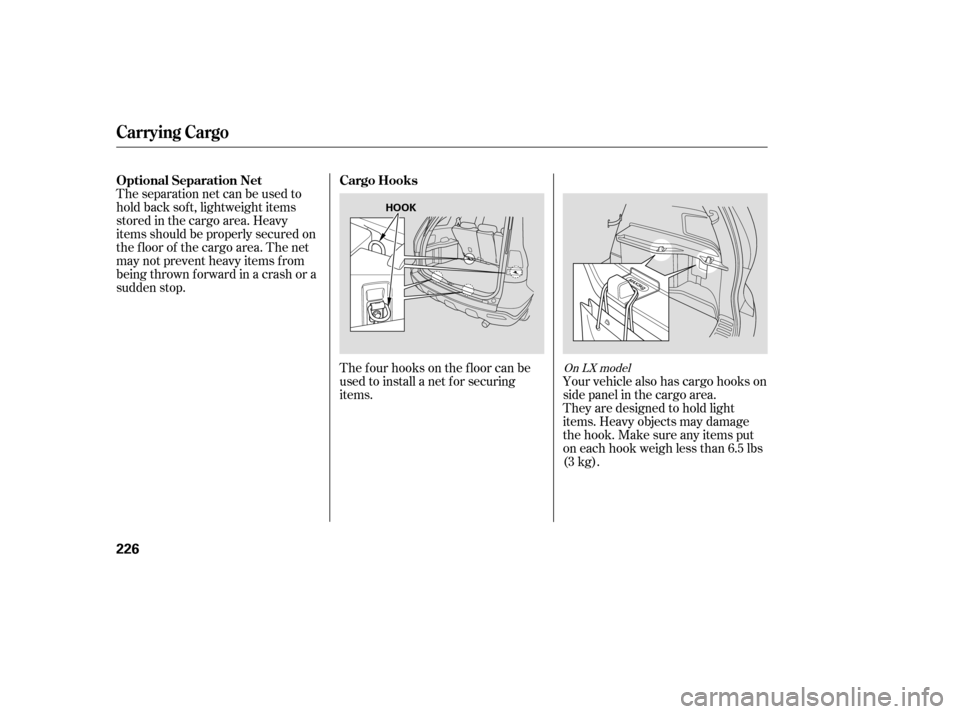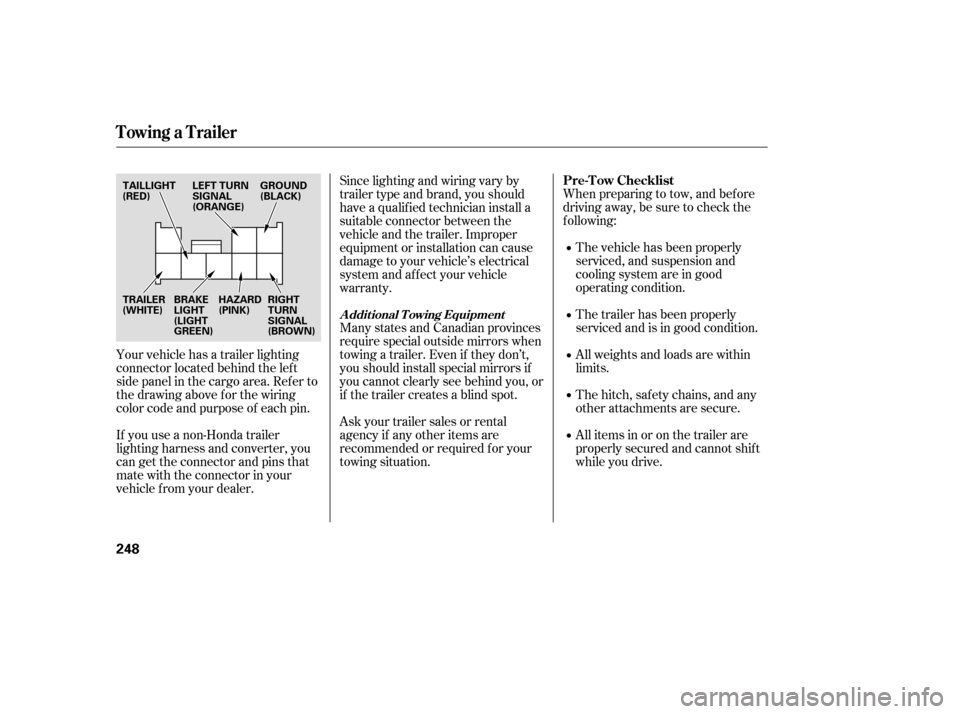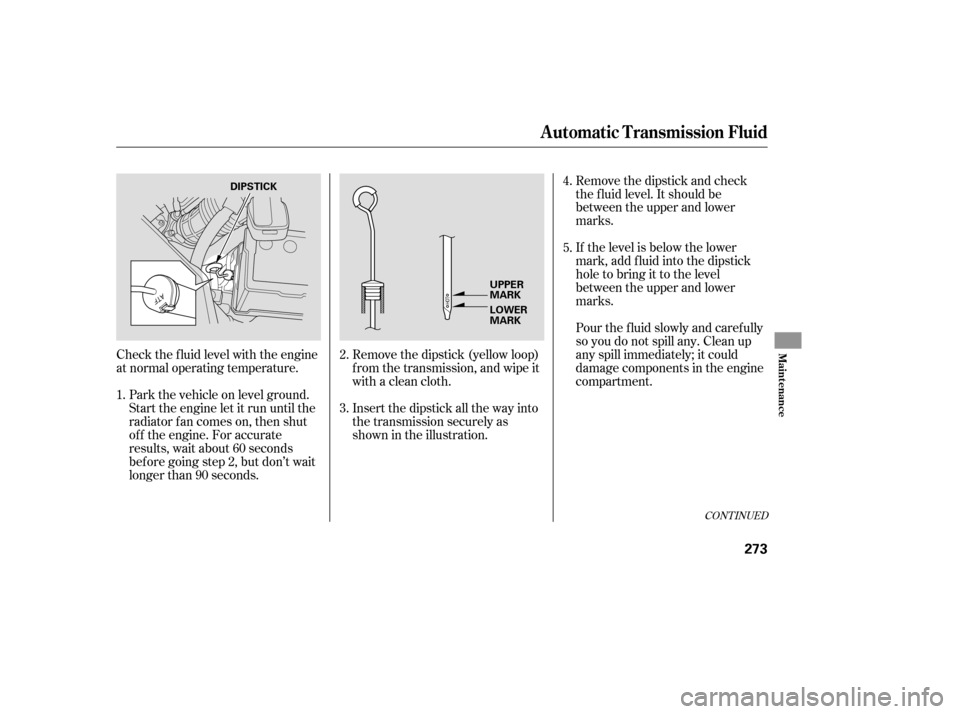ECU HONDA CR-V 2007 RD1-RD5, RE7 / 3.G Owner's Guide
[x] Cancel search | Manufacturer: HONDA, Model Year: 2007, Model line: CR-V, Model: HONDA CR-V 2007 RD1-RD5, RE7 / 3.GPages: 352, PDF Size: 5.77 MB
Page 221 of 352

To close the hood, lif t it up slightly to
remove the support rod f rom the
hole. Put the support rod back into
its holding clip. Lower the hood to
about a f oot (30 cm) above the
f ender, then let it drop. Make sure it
is securely latched.
Park the vehicle, and set the
parking brake. Pull the hood
release handle located under the
lower lef t corner of the dashboard.
The hood will pop up slightly.
Reach in between the hood and
the f ront grille with your f ingers.
The hood latch handle is above
the ‘‘H’’ logo. Push this handle up
until it releases the hood. Lif t the
hood.
If the hood latch handle moves
stif f ly, or if you can open the hood
without lifting the handle, the
mechanism should be cleaned and
lubricated.Holding the grip, pull the support
rod out of its clip. Insert the end
into the designated hole pointed
by an arrow in the hood.
2.
1. 3.
Opening and Closing the Hood
Service Station Procedures
Bef ore Driving
217
LATCH
CLIPGRIP
SUPPORT ROD
HOOD RELEASE HANDLE
Page 228 of 352

Store or secure all items that could
be thro wn around and hurt
someone during a crash.
Be sure items placed on the floor
behind the front seats cannot roll
under the seats and interfere with
the driver’s ability to operate the
pedals, the proper operation of the
seats, or proper operation of the
sensors under the seats.
Keep the lower glove box closed
while driving. If it is open, a
passenger could injure their knees
during a crash or sudden stop. If
you carry large items that
prevent you from closing the
tailgate, exhaust gas can enter the
passenger area. To avoid the
possibility of , f ollow the instructions
on page . Distribute cargo evenly on the
f loor of the cargo area, placing the
heaviest items on the bottom and
as far forward as possible. Tie
down items that could be thrown
about the vehicle during a crash or
sudden stop.
Do not stack items higher than the
back of the rear seats. They can
block your view and be thrown
around the vehicle during a crash.
If youfoldtherearseatsupor
down, tie down items that could be
thrown about the vehicle during a
crash or sudden stop. Also, keep
all cargo below the bottom of the
windows. If it is higher, it could
interf ere with the proper operation
of the side curtain airbags.
Do not use the dual deck cargo shelf
with any rear seat f olded up or down.
54
On all models except LX
Carrying Cargo
Carrying Cargo in the Passenger
Compartment
carbon monoxide
poisoning
Carrying Cargo in the Cargo A rea
or on a Roof Rack
224
Page 230 of 352

The f our hooks on the f loor can be
used to install a net f or securing
items.Your vehicle also has cargo hooks on
side panel in the cargo area.
They are designed to hold light
items. Heavy objects may damage
thehook.Makesureanyitemsput
on each hook weigh less than 6.5 lbs
(3 kg).
Theseparationnetcanbeusedto
hold back sof t, lightweight items
stored in the cargo area. Heavy
items should be properly secured on
the f loor of the cargo area. The net
may not prevent heavy items f rom
being thrown f orward in a crash or a
sudden stop.On LX model
Cargo Hooks
Optional Separation Net
Carrying Cargo
226
HOOK
Page 233 of 352

Make sure all windows, mirrors,
and outside lights are clean and
unobstructed. Remove frost, snow,
or ice.
Check that the hood is fully closed. Check
the seat adjustment (see
page ).
Check the adjustment of the
inside and outside mirrors (see
page ).
Check the steering wheel
ad justment (see page ).
Fasten your seat belt. Check that
your passengers have fastened
their seat belts (see page ).
Wh en you start the engine, check
the gauges and indicato rs in the
instrument panel (see page ).
Check
that any items you may be
carrying are stored properly or
fastened down securely.
Vi
sually check the tires. If a tire
looks low, use a gauge to check its
pressure (see page ).
Youshoulddothefollowingchecks
and adjustments bef ore you drive
your vehicle.
Make sure the doors and the
tailgate are securely closed and
locked.
1.
2.
10.14
3.
4. 5.
6.
7.
8.
9.
288 94
108 79
59
Driving Guidelines
Preparing to Drive
Driving
229
Page 240 of 352

Always use the parking brake when
you park your vehicle. Make sure
the parking brake is set f irmly, or
your vehicle may roll if it is parked
on an incline.Make sure the moonroof (if
equipped) and the windows are
closed.
Turn of f the lights.
Place any packages, valuables, etc.
in the cargo area or take them
with you.
Set the parking brake bef ore you put
the transmission in Park. This keeps
the vehicle from moving and putting
pressure on the parking mechanism
in the transmission. If the vehicle is f acing uphill, turn
the front wheels away from the
If the vehicle is f acing downhill,
turn the front wheels toward the
Make sure the parking brake is
f ully released bef ore driving away.
Driving with the parking brake
partially set can overheat or
damage the rear brakes.
Lock the doors and the tailgate.
Check the indicator on the
instrument panel to verif y that the
security system is set. Never park over dry leaves, tall
grass, or other f lammable
materials. The hot three way
catalytic converter could cause
these materials to catch on fire.
On EX and EX-L models
Parking T ips
Parking
236
curb and set the parking brake.
curb and set the parking brake.
Page 251 of 352

Trailer lights and equipment must
comply with f ederal, state, province,
and local regulations. Check with
your local trailer sales or rental
agencies f or the requirements in the
area where you plan to tow, and use
only equipment designed f or your
vehicle.
Towing can require a variety of
equipment, depending on the size of
your trailer, how it will be used, how
much load you are towing, and
where you tow.
Discuss your needs with your trailer
sales or rental agency, and f ollow the
guidelines in this section. Also make
sure that all equipment is properly
installed and maintained, and that it
meets f ederal, state, province, and
local regulations.
Seeyourtrailerdealerorrental
agency f or more inf ormation on
installing electric brakes. If you choose electric brakes, be
sure they are electronically actuated.
Do not attempt to tap into your
vehicle’s hydraulic system. No
matter how successf ul it may seem,
any attempt to attach trailer brakes
to your vehicles hydraulic system
will lower braking ef f ectiveness and
create a potential hazard. Honda requires that any trailer with
a total weight of 1,000 lbs (455 kg) or
more be equipped with its own
electric or surge-type brakes.
Always use saf ety chains when you
tow a trailer. Make sure the chains
are secured to the trailer and hitch,
and that they cross under the tongue
and can catch the trailer if it
becomes unhitched. Leave enough slack to allow the trailer to turn
corners easily, but do not let the
chains drag on the ground.
Any hitch used on your vehicle must
be properly bolted to the underbody.
CONT INUED
Towing a Trailer
T railer L ights
Trailer Brakes
Saf et y Chains
HitchesT owing Equipment and
A ccessories
Driving
247
Page 252 of 352

When preparing to tow, and bef ore
driving away, be sure to check the
f ollowing:The vehicle has been properly
serviced, and suspension and
cooling system are in good
operating condition.
The trailer has been properly
serviced and is in good condition.
All weights and loads are within
limits.
Thehitch,safetychains,andany
other attachments are secure.
All items in or on the trailer are
properly secured and cannot shif t
while you drive.
Askyourtrailersalesorrental
agency if any other items are
recommended or required f or your
towing situation. Many states and Canadian provinces
require special outside mirrors when
towing a trailer. Even if they don’t,
you should install special mirrors if
you cannot clearly see behind you, or
if the trailer creates a blind spot. Since lighting and wiring vary by
trailer type and brand, you should
have a qualif ied technician install a
suitable connector between the
vehicle and the trailer. Improper
equipment or installation can cause
damage to your vehicle’s electrical
system and af f ect your vehicle
warranty.
Your vehicle has a trailer lighting
connector located behind the lef t
side panel in the cargo area. Ref er to
thedrawingaboveforthewiring
color code and purpose of each pin.
If you use a non-Honda trailer
lighting harness and converter, you
can get the connector and pins that
mate with the connector in your
vehicle f rom your dealer.
Towing a Trailer
Pre-T ow Checklist
A ddit ional T owing Equipment
248
HAZARD
(PINK)
TRAILER
(WHITE) TAILLIGHT
(RED)
RIGHT
TURN
SIGNAL
(BROWN)
BRAKE
LIGHT
(LIGHT
GREEN) GROUND
(BLACK)
LEFT TURN
SIGNAL
(ORANGE)
Page 271 of 352

Honda Motor Oil is the pref erred
5W-20 lubricant f or your vehicle. It is
highly recommended that you use
Honda Motor Oil in your vehicle f or
optimum engine protection. Make
sure the API Certif ication Seal says
‘‘For Gasoline Engines.’’
The oil viscosity or weight is
provided on the container’s label.
5W-20 oil is f ormulated f or year-
round protection of your vehicle to
improve cold weather starting and
f uel economy.
Unscrew and remove the engine oil
fill cap on top of the valve cover.
Pour in the oil slowly and caref ully so
you do not spill any. Clean up any
spills immediately. Spilled oil could
damage components in the engine
compartment.
Reinstall the engine oil f ill cap, and
tighten it securely. Wait a f ew
minutes, and recheck the oil level on
the engine oil dipstick. Do not f ill above the upper mark; you could
damage the engine.
Oil is a major contributor to your
engine’s perf ormance and longevity.
Always use a premium-grade 5W-20
detergent oil displaying the API
Certif ication Seal. This seal indicates
the oil is energy conserving, and that
it meets the American Petroleum
Institute’s latest requirements.
A dding Engine Oil
A dding Engine Oil
Recommended Engine Oil
Maint enance
267
ENGINE OIL FILL CAP
Ambient Temperature
API CERTIFICATION SEAL
Page 277 of 352

CONT INUED
Check the f luid level with the engine
at normal operating temperature.Park the vehicle on level ground.
Start the engine let it run until the
radiator f an comes on, then shut
of f the engine. For accurate
results, wait about 60 seconds
bef ore going step 2, but don’t wait
longer than 90 seconds. Remove the dipstick and check
the f luid level. It should be
between the upper and lower
marks.
If the level is below the lower
mark, add f luid into the dipstick
hole to bring it to the level
between the upper and lower
marks.
Insert the dipstick all the way into
the transmission securely as
shown in the illustration. Remove the dipstick (yellow loop)
f rom the transmission, and wipe it
with a clean cloth. Pour the f luid slowly and caref ully
so you do not spill any. Clean up
any spill immediately; it could
damage components in the engine
compartment.
1. 2.
3.5. 4.
Automatic Transmission Fluid
Maint enance
273
DIPSTICK
UPPER
MARK
LOWER
MARK
Page 278 of 352

Insert the dipstick all the way back
into the transmission securely as
shown in the illustration. Always use Honda ATF-Z1
(automatic transmission f luid). If
it’s not available, you may use a
DEXRON
III automatic
transmission f luid as a temporary
replacement. However, continued
use can affect the shift quality.
Have the transmission f lushed and
ref illed with Honda ATF-Z1 by
your dealer as soon as it is
convenient.
Make sure the rubber cap on the
dipstick f its in the dipstick guide
and that you push the dipstick in
all the way.
If you are not sure how to add f luid,
contact your dealer. 6.
Automatic Transmission Fluid
274